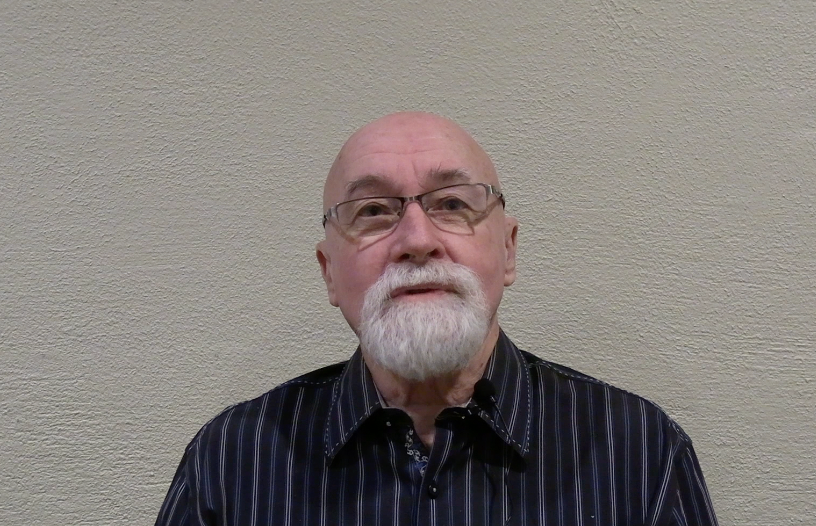Using Double Mass Selection and Reaction Cell Gases to Resolve Isobaric Spectral Overlaps in ICP-MS
Special Issues
When using a triple-quadrupole ICP-MS system, the increased abundance sensitivity of MS/MS mode makes it possible to measure trace elements using isotopes that would otherwise be affected by peak tailing from an adjacent major element. This approach is illustrated using the example of ultratrace 237Np analysis in the presence of 10 ppm U.
Collision–reaction cell methods are now almost universally accepted in quadrupole inductively coupled plasma–mass spectrometry (ICP-MS) applications. Helium collision mode provides dramatic improvements in detection limits and accuracy of quantitation for many elements by reducing the relative transmission of polyatomic ions compared to the monatomic analyte ions that they overlap. However, spectral interferences that are not caused by polyatomic ions cannot be controlled effectively using helium collision mode. One important example is isobaric overlaps, where isotopes of two different elements occur at the same mass. Reactive cell gases can provide a solution to isobaric overlaps if a gas is selected that reacts quickly with one of the isobaric elements and slowly, or not at all, with the other. This approach, termed "chemical resolution," allows the target isotope to be resolved from the overlapping isobar. To control the reaction chemistry and to ensure that only the intended product ions are measured, an additional mass selection step (before the collision/reaction cell) is essential. This is achieved using a tandem mass spectrometry system (ICP-MS/MS), such as a triple-quadrupole configuration. In this work, we present application examples where ICP-MS/MS was used to separate isobaric overlaps, allowing accurate analysis to be performed.
The development of collision–reaction cells in inductively coupled plasma–mass spectrometry (ICP-MS) around 20 years ago transformed the ability of analysts to address spectral interferences. In practical applications, the use of helium (He) collision cell gas and kinetic energy discrimination (KED) has been particularly effective to reduce polyatomic ion overlaps (1). Helium mode has improved the accuracy of ICP-MS results for many previously problematic analytes, such as the first-row transition elements, which suffer from multiple polyatomic overlaps in common sample types.
However, while He mode may be viewed as a near universal approach to reducing polyatomic ion interferences in ICP-MS (2), it is not at all effective for certain other spectral overlaps. He mode cannot resolve the isobaric (same mass) interferences that occur when two (or more) different elements have an isotope at the same nominal mass (for example, 204Hg and 204Pb at m/z 204). These isotopes are much too close to be mass-resolved using sector-field "high-resolution" ICP-MS. The resolution (M/ΔM) required to separate the Hg/Pb isobars is almost 500,000, whereas sector-field ICP-MS instruments are limited to a resolution of about 10,000 (3). Direct interelement overlaps can also occur because of peak "tailing" from an adjacent mass; for example, boron analysis in organic solvents is affected by the low-mass tail from 12C, which extends across the 11B peak.
All naturally occurring elements (except indium) have at least one isotope that is free from direct overlap from an isotope of another element, so isobaric overlaps should theoretically be avoidable. But the "free" isotope is not always the most abundant, and may be severely affected by other interferences, such as matrix-based polyatomic ions. Consequently, there may be analytical benefits to measuring an alternative isotope, even one that has an isobaric overlap, if a method can be devised to avoid or remove the overlapping isotope.
Also, some applications require the measurement of more than one isotope, for example when isotope dilution is used for quantitative analysis, or where natural variations in isotopic abundances are studied. Isotopic dating (geochronology) studies require the analysis of two or more isotopes of an element to measure the degree of isotopic fractionation or radioactive decay over time. These applications require the accurate measurement of a second isotope, and such secondary isotopes often suffer overlap from isotopes of other elements.
Isobaric Overlaps on Natural and Radiogenic Isotopes
Methods to address some isobaric overlaps are well-established, such as the use of cool plasma (4) or a reaction gas (5) to remove the interference from the major isotope of argon (40Ar, 99.6%) on the major isotope of calcium (40Ca, 96.94%) at m/z 40. Removing the 40Ar allows the major Ca isotope to be measured, enabling trace level analysis of Ca in semiconductor process chemicals.
Other isobaric overlaps are less well-known, but may impact ICP-MS performance for emerging applications. One example is the increasing need to monitor elements arising from high-technology industries and manufacturing. Elements including Ga, Ge, Nb, In, Te, and Ta may be important environmental contaminants, and their behavior and potential toxicological impact are not well understood (6). These elements can be measured using ICP-MS; indeed Ge, In, and Te are commonly used as internal standards. But some of these elements are difficult to measure at low levels and, because their natural background levels in the environment are extremely low, analytical methods must be carefully optimized.
For example, Te detection limits are degraded by its relatively poor ionization. The first ionization potential of Te is 9.01 eV, similar to other poorly ionized elements, Be, Cd, and Zn, so Te is only about 25% ionized in a normal ICP. Also, the only Te isotope that is free from isobaric overlap is 125Te, so this is the preferred Te isotope for ICP-MS measurements. But 125Te has an isotopic abundance of only 7.07%, so the sensitivity is reduced by almost a factor of five compared to the most abundant Te isotope. To measure Te at low levels in environmental samples, it would be beneficial to be able to measure the more abundant isotopes, 128Te (31.74%) and 130Te (34.08%). However, both these isotopes suffer isobaric overlaps from Xe (a common trace contaminant in high-purity argon gas), while 130Te is also overlapped by 130Ba, which may be present at milligram-per-kilogram (part-per-million) levels in natural environmental samples. An ICP-MS/MS method that removes the Xe and Ba isobaric overlaps would significantly improve the trace determination of Te.
Analysis of non-natural, radiogenic isotopes of interest in the nuclear industry can also be compromised by isobaric overlaps. These elements may need to be monitored following accidental release, or from decommissioning, waste disposal, or weapons testing activities. There is increasing interest in the potential of ICP-MS as a rapid technique for measuring radiogenic isotopes with long half-lives and therefore low specific activity (7). Radiogenic isotopes are frequently overlapped by isotopes of naturally occurring elements, which may be present at much higher concentration than the radiogenic isotope of interest. Examples include 41Ca (overlapped by natural 41K), 59Ni (59Co), 93Zr (93Nb) (8), 129I (129Xe) (9), 135Cs (135Ba) (10), and 151Sm (151Eu) (11). Radiometric techniques are ideal for measuring the highly radioactive isotopes (such as 90Sr and 137Cs) that are monitored after an accidental release. But activity-based techniques are less suitable for the lower activity levels of the long-lived radioisotopes that persist in the environment long after the initial release. For these isotopes, the ability of ICP-MS/MS to resolve isobaric overlaps may offer a superior detection capability compared to traditional radiometric approaches.
Theoretically, the reaction chemistry used to resolve isobaric interferences should be applicable to quadrupole ICP-MS instruments with a simple collision–reaction cell, or a bandpass filter before or in the cell. However, these configurations do not possess a true (1 u) mass filter upstream of the collision–reaction cell, so are unable to selectively pass only one precursor ion mass to the cell. As a result, the reaction chemistry is nonspecific, and the product ions formed are unpredictable, and vary with the sample composition. These errors are eliminated using MS/MS mode on a triple-quadrupole ICP-MS system.
Abundance Sensitivity Overlaps
Isotopic overlaps from one element on another can also occur due to peak "tailing" from an adjacent mass. The efficiency with which a mass filter separates adjacent masses is called the abundance sensitivity (AS). This figure indicates the contribution that a peak makes to its neighbors, expressed as a ratio of the peak intensities.
The mass spectrometer used in a typical quadrupole ICP-MS system operates with AS of about 10-7. This means that a peak of 107 counts per second (cps) would contribute 1 cps to the masses 1 u above and below. If a trace analyte occurs next to an intense major element peak, accurate determination of the analyte can be difficult or impossible. Examples include the measurement of boron in organic solvents, and trace manganese analysis in an iron-rich matrix. The intense 56Fe peak tails across the 55Mn peak, contributing to the background at m/z 55 and affecting the accuracy of Mn results. In the nuclear industry, radiogenic isotopes that must be measured at extremely low levels can also be impacted by peak tailing, such as trace neptunium 237, measured next to the major isotope of U (238).
Tandem mass spectrometry offers an interesting solution for these peak tailing overlaps, since the double mass selection of MS/MS improves the AS of the instrument. When both quadrupoles (before and after the cell) of a triple-quadrupole ICP-MS system are operated as true mass filters with a mass resolution of ~0.75 u (MS/MS mode), the overall AS of the instrument is the product of the AS of the two quadrupoles, so 10-7 x 10-7 = 10-14. This dramatically improves the ability to separate a trace peak from an intense peak at an adjacent mass.
Experimental
Instrumentation and Reagents
An Agilent 8900 ICP-QQQ system (model 100, Advanced Applications Configuration) was used for all measurements. The instrument was fitted with a glass concentric nebulizer, quartz spray chamber, standard quartz torch with 2.5-mm injector, and standard nickel sampling and skimmer cones. Samples were introduced via the built-in peristaltic pump fitted with 1.02-mm i.d. pump tubing.
A mix of cell gases (N2O and NH3) was used to resolve the Xe and Ba overlaps on Te at m/z 128 and 130. Helium was also added to the cell as a buffer gas. For 237Np analysis, oxygen (O2) cell gas was used with mass-shift mode to resolve the isobaric interference from the 238U peak tail and the polyatomic overlaps from UHx that interfere with the trace determination of 237Np. The main operating conditions of the instrument are shown in Table I.
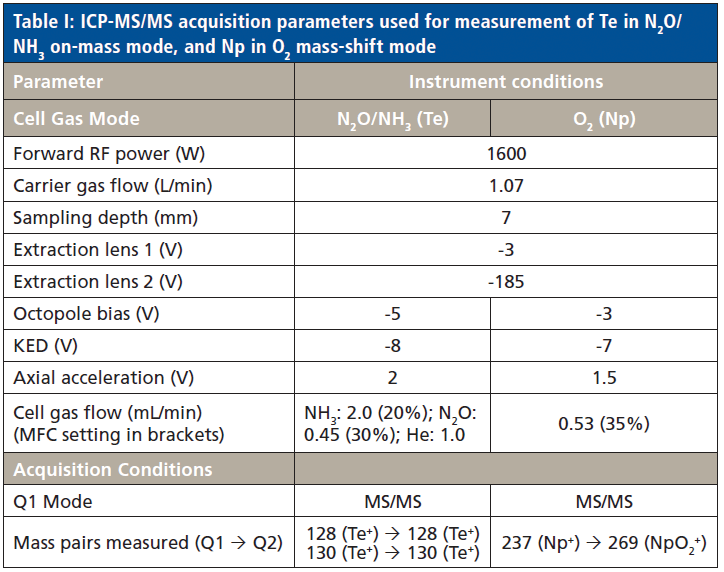
Table I: ICP-MS/MS acquisition parameters used for measurement of Te in N2O/NH3 on-mass mode, and Np in O2 mass-shift mode
Tellurium calibration standards and Ba matrix solutions were prepared from single-element stock solutions (Agilent Technologies). Ultrapure water was prepared in the laboratory using a Milli-Q Element system (Merck-Millipore), and nitric and hydrochloric acids used for sample stabilization were Ultrapure NORMATOM grade (VWR Chemicals).
The U matrix for the Np determination was obtained from Agilent, and the trace 237Np standard was measured as part of an instrument evaluation by Springfields Fuels Ltd., UK (12).
Results and Discussion
Resolving Isobaric Overlaps on Tellurium
A mix of N2O and NH3 cell gases plus He buffer gas was used to resolve the isobaric interferences on the two most abundant isotopes of Te at m/z 128 and 130. The improvement in trace detection of Te due to the removal of the Xe isobaric overlap is illustrated in the calibrations from 1 to 1000 ng/L (ppt) shown in Figure 1 (scales zoomed to ~200 ppt for clarity). The two major isotopes of Te, 128Te (left) and 130Te (right), are shown. The upper pair of calibration plots show the calibrations in no gas mode. The y-axis offset is due to the 128Xe and 130Xe contributing to the blank signal, giving background equivalent concentrations (BECs) of 16 ng/L for 128Te and 32 ng/L for 130Te. The difference in the BECs is due to the ~2x higher abundance of 130Xe, compared to 128Xe. In N2O/NH3 cell gas mode (lower pair of plots), the y-axis offset is completely removed (background signals of 0.3 and 0.2 cps), leading to BECs of 0.029 ng/L and 0.017 ng/L for 128Te and 130Te, respectively. N2O/NH3 mode reduced the BEC by a factor of more than 500 for 128Te and almost 2000 for 130Te.
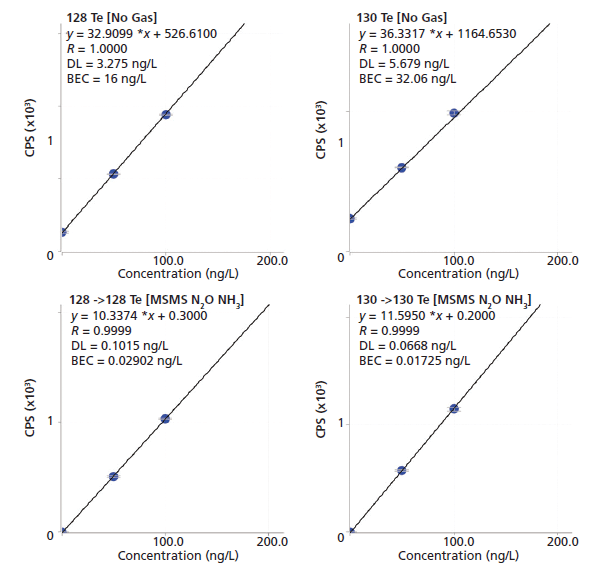
Figure 1: Zoom to show low level calibrations for 128Te (left) and 130Te (right) in no-gas mode (top) and MS/MS mode with N2O/NH3 cell gas (bottom).
The mixed cell gas method allows the isobaric overlaps from both Xe and 130Ba on 130Te to be removed using the same cell conditions. This was tested using a series of Ba standards from 20 to 1000 µg/L (ppb). Each Ba standard was spiked with 500 ng/L Te, and measured in both no-gas mode and N2O/NH3 cell gas mode. The measured Te concentrations are shown in the plot in Figure 2, and the recoveries are given in Table II. In no-gas mode, the lowest Ba concentration (20 ppb) gave around 50% error in the Te recovery. In 1000 ppb Ba, the 130Ba contribution led to a reported Te concentration almost 30x higher (2909% recovery) than the true Te concentration. In N2O/NH3 mode, the Te recoveries were within ± 3% for all Ba concentrations.

Table II: Recovery of 500 ng/L (ppt) Te spike
measure at 130Te in variable Ba matrix levels using MS/MS mode with N2O/NH3 cell gas, and no gas mode
Using MS/MS to Separate 237Np from 238U Peak Tail
Trace 237Np was measured in a uranium matrix using MS/MS mass-shift mode with O2 cell gas. Mass shift refers to the mode of operation where Q1 (before the cell) is set to the precursor ion of interest (237Np in this case) and Q2 (after the cell) is set to the target product ion mass (NpO2 at m/z 269 in this case). The mass transition for Np analysis is Np+ → NpO2+, which is favorable for Np+ and less favorable for the potential polyatomic overlaps (235U1H2+, 235U2H+, 234U2H1H+) that can affect ultratrace-level Np analysis when U is present. U+ does form a UO2+ product ion with O2 cell gas, but Q1 is set to m/z 237 for 237Np analysis, so the 238U+ ions are rejected by Q1. The abundance sensitivity of Q1 (10-7) ensures that only very low residual 238U+ enters the cell when Q1 is set to pass 237Np+. Following the mass transition M+ → MO2+ in the cell, the potentially interfering product ion 238UO2+ (at m/z 270) then undergoes a further mass filtering step in Q2. This reduces the contribution from 238UO2+ on the product ion of interest (237NpO2+ at m/z 269) by a further 107. So, 237Np is measured completely free from U overlap. This is illustrated in the spectrum in Figure 3, which shows overlaid 237Np standards from 0.19 to 9.5 ng/L (ppt), each prepared in a matrix of 10 mg/L (ppm) U. The calibration presented in Figure 4 shows that the BEC for 237Np in the 10 ppm U matrix was 0.32 pg/L (ppq), demonstrating the ability of triple-quadrupole ICP-MS to separate adjacent mass overlaps by utilizing the improved abundance sensitivity of MS/MS.
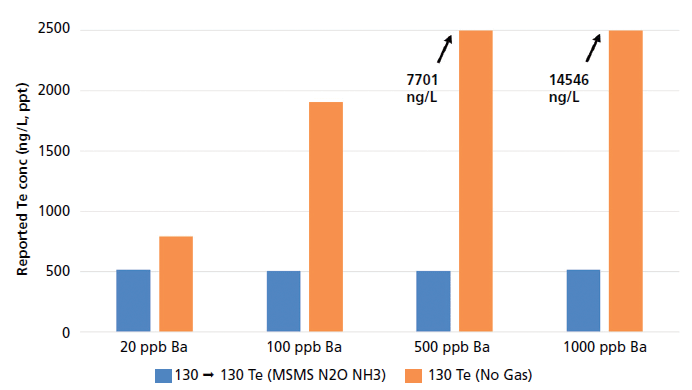
Figure 2: Recovery of 500-ng/L (ppt) Te spike measured at 130Te in varying Ba matrix levels, in MS/MS mode with N2O/NH3 cell gas, and in no-gas mode.
Conclusions
Double mass selection (MS/MS) in a triple-quadrupole ICP-MS system has been applied to resolving direct, isobaric overlaps and peak tailing contributions from adjacent peaks. Isobaric overlaps can be chemically resolved using controlled, selective reaction chemistry in the collision–reaction cell of the ICP-MS/MS system. This approach allows normally inaccessible isotopes to be measured, providing improved analytical performance and enabling isotope ratio and isotope dilution measurements.
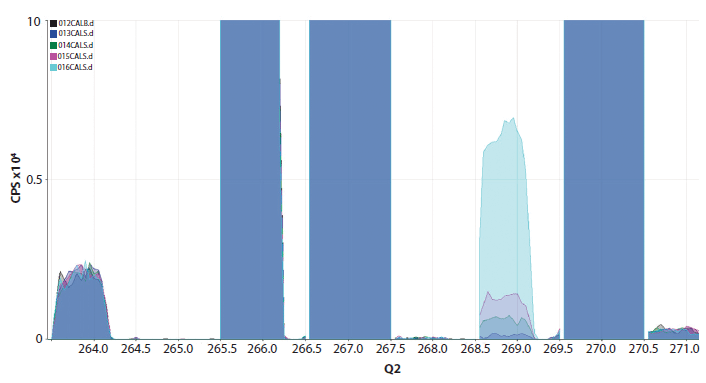
Figure 3: Overlaid spectra for 237Np standards at 0, 0.19, 0.95, 1.9, and 9.5 ng/L (ppt) in U matrix of 10 mg/L (ppm), showing baseline separation of 237Np product ion (237NpO2+ at m/z 269) from U matrix peak (238UO2+ at m/z 270) using MS/MS.
The improved abundance sensitivity of MS/MS mode also offers analysts the possibility to measure trace elements using isotopes that would otherwise be affected by peak tailing from an adjacent major element. This approach is illustrated using the example of ultratrace 237Np analysis in the presence of 10 ppm U.
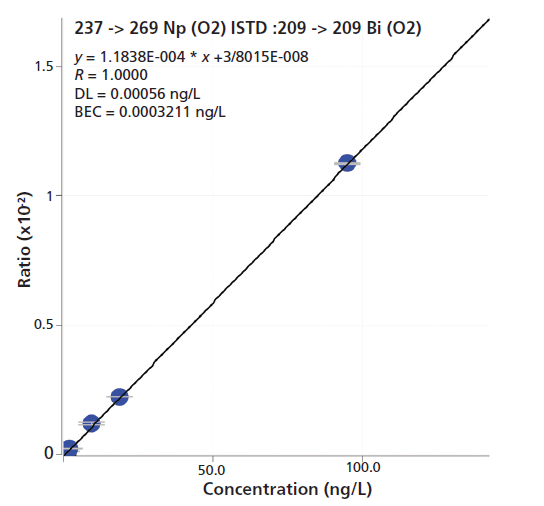
Figure 4: Calibration for 237Np in 10 ppm U matrix, showing BEC of 0.32 pg/L (ppq) and DL of 0.56 pg/L in MS/MS mass-shift mode with O2 cell gas.
References
(1) N. Yamada, J. Takahashi, and K. Sakata, J. Anal. At. Spectrom. 17, 1213 (2002).
(2) E. McCurdy and G. Woods, J. Anal. At. Spectrom. 19, 607–615 (2004).
(3) N. Jakubowski, T. Prohaska, L. Rottmann, and F. Vanhaecke, J. Anal. At. Spectrom. 26, 693–726 (2011).
(4) K. Sakata and K. Kawabata, Spectrochimica Acta, Part B 49, 1027–1038 (1994).
(5) S.D. Tanner, V.I. Baranov, and U. Vollkopf, J. Anal. At. Spectrom. 15, 1261–1269 (2000).
(6) M. Filiella and I. Rodushkin, 2018, Spectrochimica Acta, Part B 141, 80–84 (2018).
(7) I.W. Croudace, B.C. Russell, and P.W. Warwick, J. Anal. At. Spectrom. 32, 494–526 (2017).
(8) P. Petrov, B. Russell, D.N. Douglas, and H. Goenaga-Infante, Anal. Bioanal. Chem. 410, 1029–1037 (2018).
(9) G. Yang, H. Tazoe, and M. Yamada, Analytica Chimica Acta 1008, 66–73 (2018).
(10) G. Yang, Y. Kato, H. Tazoe, and M. Yamada, Geochemical Journal (51), 1–8 (2017).
(11) M. G. Miranda, B. Russell, and P. Ivanov, J. Radioanal. Nucl. Chem. 316, 831–838 (2018)
(12) G. Duckworth and G. Woods, "Accurate Analysis of Neptunium 237 in a Uranium Matrix, Using ICP-QQQ with MS/MS," 2017, Agilent publication 5991-6905EN.
Ed McCurdy and Glenn Woods are with Agilent Technologies LDA (UK) Ltd. Direct correspondence to: ed_mccurdy@agilent.com
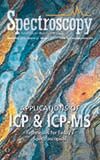
How Do We Improve Elemental Impurity Analysis in Pharmaceutical Quality Control?
May 16th 2025In this final part of our conversation with Harrington and Seibert, they discuss the main challenges that they encountered in their study and how we can improve elemental impurity analysis in pharmaceutical quality control.
High-Speed Laser MS for Precise, Prep-Free Environmental Particle Tracking
April 21st 2025Scientists at Oak Ridge National Laboratory have demonstrated that a fast, laser-based mass spectrometry method—LA-ICP-TOF-MS—can accurately detect and identify airborne environmental particles, including toxic metal particles like ruthenium, without the need for complex sample preparation. The work offers a breakthrough in rapid, high-resolution analysis of environmental pollutants.

.png&w=3840&q=75)

.png&w=3840&q=75)



.png&w=3840&q=75)



.png&w=3840&q=75)






